|
A
study of Enlisted Invalid Corps jackets 1863-1866
by Christopher J. Daley
|
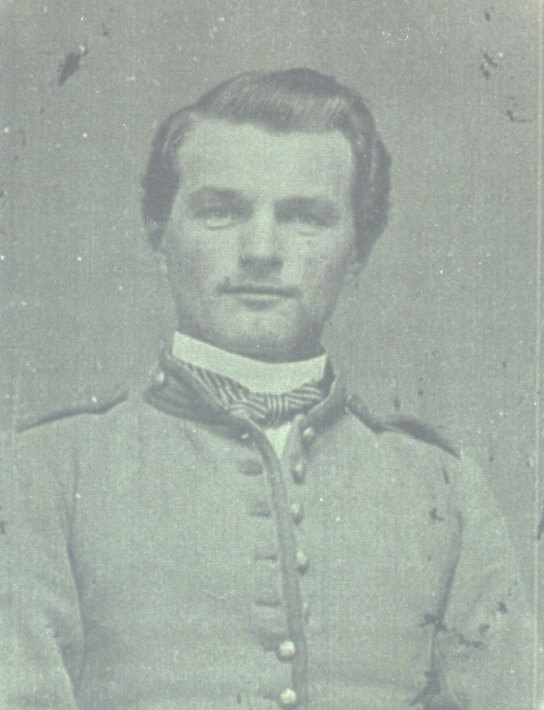 This
page is broken into two parts: The History of the Invalid
Corps Jacket and an Examination of a Schuylkill
Arsenals Invalid Corps Jackets. This is all a work in
progress so if you have any additional information on Invalid Corps
Jackets, please let me know. This
page is broken into two parts: The History of the Invalid
Corps Jacket and an Examination of a Schuylkill
Arsenals Invalid Corps Jackets. This is all a work in
progress so if you have any additional information on Invalid Corps
Jackets, please let me know.
(Note:
As explained in this article, the unit designation of "Invalid
Corps" was changed to "Veteran Reserve Corps (VRC)" in 1864. For the
sake of continuity, I have chosen to use the designation of "Invalid
Corps" throughout the text.)
Part I: The History of the Invalid Corps Jacket
As early
as 22 April 1777 the War of Board of the Continental Congress
established a "Corps of Invalids" whose main purpose was not as
active combatants, but rather a supportive unit. Under the command
of Colonel Lewis Nicolas these men were charged with guarding
magazines, arsenals and to serve as drill instructors for new
recruits. The only requirement was that the invalid not have more
than a single amputation.1
|
In
the War Between the States a similar numbers shortage in
November of 1862 forced the War Department to issue General
Orders 36. This order authorized secure medical officers to use
convalescents as nurses, cooks and attendants in a hospital to
aid the growing number of wounded in the wake of the Maryland
Campaign. The formal creation of The Invalid Corps (renamed the
"Veteran Reserve Corps" on 18, March 1864 for morale reasons)
came on 22 March 1863 with General Orders 63:
At every U.S. General Hospital, the feeble and wounded men,
unfit for field duty, but not entirely disabled, instead of
being discharged, will be organized into detachments, under the
charge of the officers acting as military commanders, who will
assign men to them from time to time, in the reports of the
surgeons in charge of the hospitals. From these invalid
detachments the military commanders will make details for
provost, hospital and other necessary guards: for clerks,
hospital attendants, nurses, cooks and other extra duty men.
The new Invalid Corps was to be organized into three battalions:
Recruits of the battalion should be capable of using a
musket; those of the Battalion are to have the use of one of the
upper extremities ; those of the battalion are to have the use
of at least one of their lower extremities. No third
battalion was ever formed, but over 60,000 officers and men
served in the corps throughout the remained of the conflict.
1,664 died while a member of the service, 24 in actions, the
remained of disease and wounds suffered in regular service. |
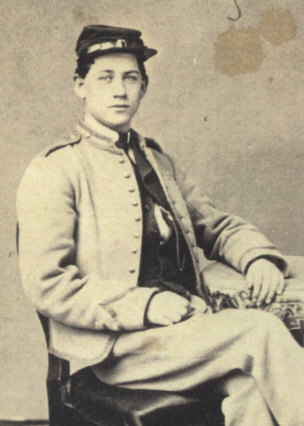
This Invalid Corps Private is wearing one of the many
variations that can bee seen in Invalid Corps Jackets. This
Jacket has a lower collar with no 'false buttonhole" and the
shoulder strap is rounded.
(courtesy of Guy Smith) |
This
unique corps also adopted a unique uniform. General Orders 124 on 15
May 1863 outlined the uniform as follows: The following uniform
has been adopted for the Invalid Corps: Jacket: Of Sky-blue kersey,
with dark-blue trimmings, cut like the jacket of the U.S. Cavalry,
to come well down on the loins and abdomen; Trousers: Present
regulation, sky-blue; Forage Cap: present regulation
 The
jacket was to be designed and fashioned in such a way as to give the
members of this new organization a sense of heightened pride and
esprit-de-corps. In fact this uniform marked the members as cripples
and shirkers. As the regulations for most state, volunteer and U.S.
Regular infantry regiments called for a dark blue coat, this new
garment precluded the wearer from being confused for regular
soldier. The
jacket was to be designed and fashioned in such a way as to give the
members of this new organization a sense of heightened pride and
esprit-de-corps. In fact this uniform marked the members as cripples
and shirkers. As the regulations for most state, volunteer and U.S.
Regular infantry regiments called for a dark blue coat, this new
garment precluded the wearer from being confused for regular
soldier.
Soldiers
North and South marked the veteran soldiers and called them
"Condemned Yanks"2 or "Inspected-Condemned". The later
was a term used by the quartermaster inspectors who rejected
inferior equipage or worn out goods. The "I.C." stamp used by the
inspectors was unfortunately the same initials for the Invalid
Corps.
Captain
J.W. DeForest, the last commander of the corps would write in a
final report, his observation regarding the adoptions of the Invalid
Corps Jacket.
 The
Uniform was becoming, but has never been popular. The men did not
like to be distinguished from their comrades of the active service
by a particular costume; they wanted to keep the dark blue blouse
and dress coat in which they had learned their profession and
received their honorable disabilities. This feeling was aggravated
by the inevitable jealousy between field and garrison regiments,
which ripened into something like bitterness between the soldiers
of the Invalid Corps and the ranks in which they had so lately
marched and fought.3 The
Uniform was becoming, but has never been popular. The men did not
like to be distinguished from their comrades of the active service
by a particular costume; they wanted to keep the dark blue blouse
and dress coat in which they had learned their profession and
received their honorable disabilities. This feeling was aggravated
by the inevitable jealousy between field and garrison regiments,
which ripened into something like bitterness between the soldiers
of the Invalid Corps and the ranks in which they had so lately
marched and fought.3
To add
to the stigma of the uniform it self, some Invalid Corps officers
forced the regulations upon the enlisted men to the point of
punishment. Pvt. Alfred Bellard, noted one senior officer who seemed
to delight in the discomfort of his troops even when off duty.
We
were now under strict military rule not being allowed to wear
anything that was not issued by the government, even our shoes.
When out on pass, we must have out jackets buttoned up to our
chin, waist belt on and also white gloves. Our major, who was an
officer of the regular army, and had but one eye, tried to make
himself very conspicuous. While I was walking along Penn. Ave. one
day out on pass I had my corps badge and shield on my jacket, and
that was unbuttoned, when who should come along but the major, who
ordered me to take off my badges and button my jacket. I did
neither, only while I was in his sight. He ordered me back on one
occasion, when I was going out on pass, he being at the gate, to
take off my fancy cap and store bought boots, and put on the gov't
pontoons before I could pass the guard. At the next parade, I had
no army cap and the one the Lieut. Got for me was some two sizes
too large and came down over my ears, I made it answer by pinning
it up.4
Bellard
kept an accurate account of his days with the Invalid Corps and made
several observations about his uniform, along with color sketches of
the same. The New Jersey native was assigned to the 97th Company of
the 1st Battalion of Invalids.5 Soon after being assigned
to that unit, on the 15th of October he was issued his uniform:
We received our arms and equipment, an extra pair of pants and the
blue jacket of the Invalid Corps. The jacket was made of light blue
cloth with black braid for trimming and nine small brass buttons
down the front.6
 Pvt.
Alfred Bellard's Sketch of Pvt.
Alfred Bellard's Sketch of
The Invalid Corps Uniform
Bellard's description of his newly issued suit bears little
resemblances to the regulations prescribed by the War Department. As
the U.S. Cavalry jackets were to be made with 12 buttons instead of
the nine Bellard's had His jacket also had "black trimming", not
dark blue trim.
As you
will see in this study Bellard's jacket is not the only variation of
the Invalid Corps Enlisted Jacket issued to the soldiers. In fact
the jacket was quite different to the specification called for in
General Order 124. The extant Invalid Corps jackets vary greatly as
to the prescribed "U.S. Cavalry Jacket" or Mounted Services pattern.
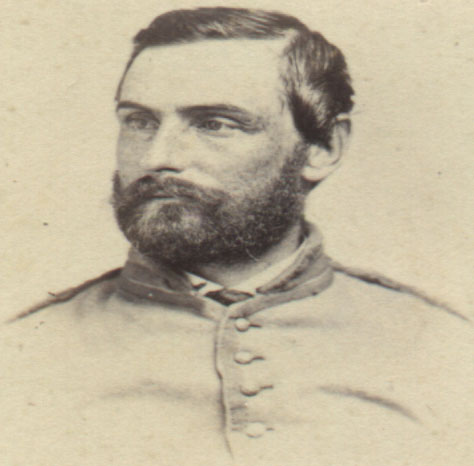 The
mounted services pattern called for a 12 button front, a survey of
extant examples, diary accounts and images shows 9, 11 and 12 button
Invalid Corps jackets. The tape surveyed in extant examples was 1/2
worsted twill, double-chevron weave trim. According to pattern, the
mounted services jackets were to be made with 3/8" trim, extant
examples support this. While the mounted services jackets are
trimmed with two "false-button" holes on the collar, the Invalid
Corps only has one. The Invalid Corps jacket is also missing the
trim along the back seams which is prescribed for and found on
extant mounted services jackets. The
mounted services pattern called for a 12 button front, a survey of
extant examples, diary accounts and images shows 9, 11 and 12 button
Invalid Corps jackets. The tape surveyed in extant examples was 1/2
worsted twill, double-chevron weave trim. According to pattern, the
mounted services jackets were to be made with 3/8" trim, extant
examples support this. While the mounted services jackets are
trimmed with two "false-button" holes on the collar, the Invalid
Corps only has one. The Invalid Corps jacket is also missing the
trim along the back seams which is prescribed for and found on
extant mounted services jackets.
The
Invalid Corps jackets were cut longer and have more of a chasseur
look to them, as with most chasseur jackets, the Invalid Corps
jacket has a vent at the base of the side seam to allow the garment
to break over the hips naturally. This feature, along with trimmed
epaulets, are also missing on mounted service jackets.
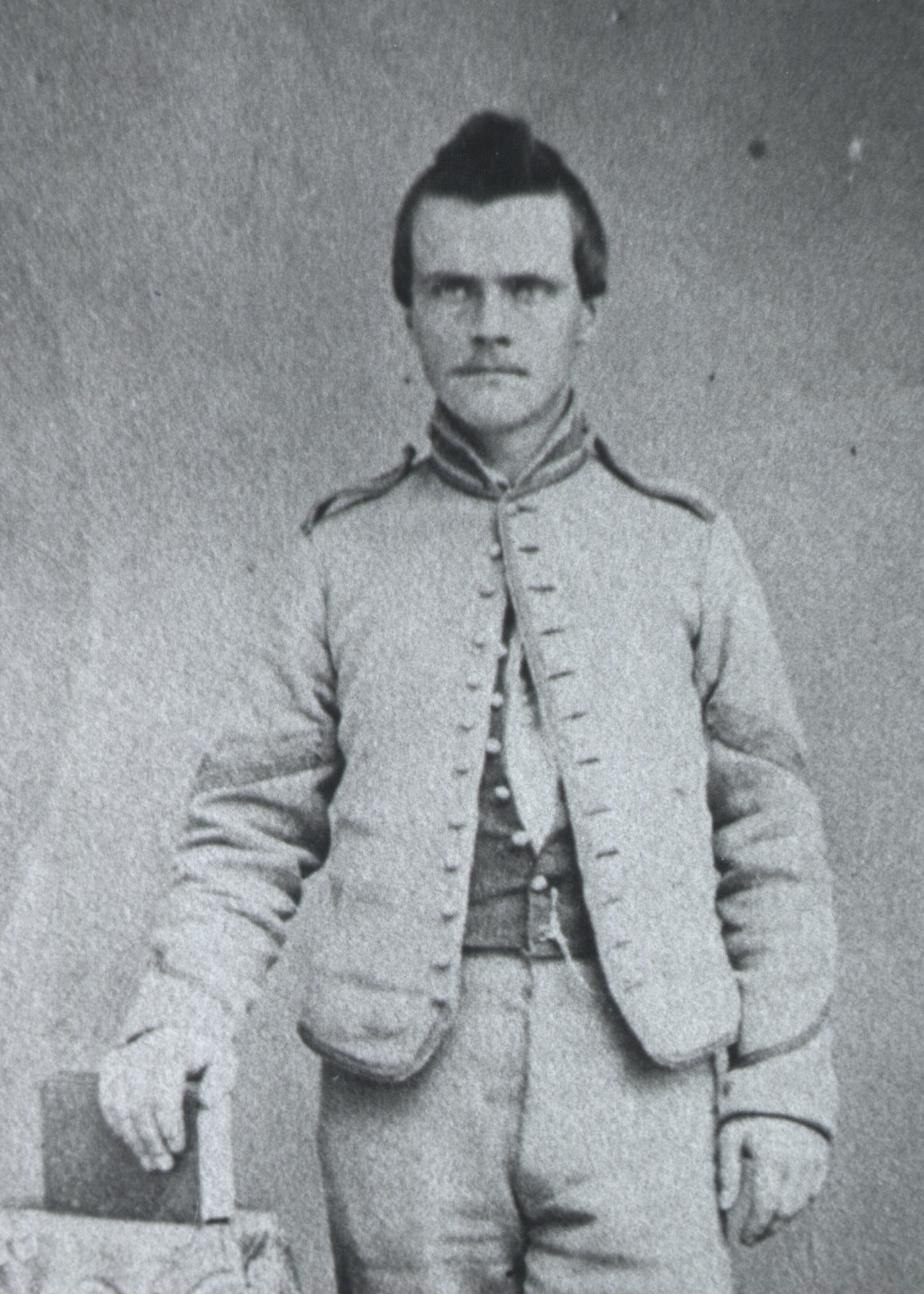 This
corporal is in the 172d Company, This
corporal is in the 172d Company,
2d Battalion, and was photographed by
P. Olmsted & Co., Davenport, Iowa
(courtesy of Philip Katcher)
Several
other features prescribed by regulations to be included in the
mounted services jacket are missing from the Invalid Corps jackets,
including a functional cuff and bolsters. The bolsters were two
small rectangle pieces of cloth sewn into the rear seams of the
mounted services jackets. These trimmed "pillow-shape" devices were
used to hold up or 'bolster' the issue saber belt.
A final
difference in pattern to the mounted services coat is the height of
collar which seams to be slightly lower on most Invalid Corps
Jackets. By 1864 the regulations were:
Jacket for Veteran Reserve Corps: 1 1/4 yards of 6-4 sky blue
kersey; 1 yard of 7/8 white or grey flannel or linsey lining; 1
1/8 yards of 4-4 unbleached muslin; I inch of 4-4 brown holland; 6
yards of I/2 inch dark blue worsted lace; 16 vest buttons; 7
skeins of dark blue linen thread, No. 35; 1 black hook and eye.
For musicians, add 5 yards of lace and 2 skeins of thread.
To view the regulations
for the mounted services jacket, please visit:
Uniform Study: St.
Louis Depot Mounted Services Artillery Jacket
There
were two patterns developed for the Invalid Corps Jacket. The first
pattern was the "Prototype Invalid Corps Jacket". There is one
sealed sample piece in the collection of the Smithsonian Institute
which was produced as a prototype. This jacket is longer, has
separate skirt pieces and was never produced and issued to the
Invalid Corps.
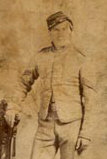
The
second pattern Invalid Corps Jacket didn't have a separate skirt
piece, but exhibited many of the same features as the prototype.
Only one pattern was used by the Schuylkill Arsenal, the Cincinnati
Depot and contractors. The variations that occur among Invalid Corps
jackets are "style" differences and are not pattern changes. Among
the variations seen in jackets are the amount of buttonholes,
anywhere from the prescribed 12, to as few as 9. The trim on the
collar is also a style variation. Most of the Invalid Corps jackets,
and all the ones surveyed from the Schuylkill Arsenal, have a
one-double row of lace on the collar to emulate a false buttonhole.
Some photos exhibit one-single row of lace and some jackets lack
this feature all together.
Research
is still being done on the Invalid Corps Jacket and please visit
this site frequently for, new photos and finds on this unique
military garment. |
|
Part II: Invalid Corps Jacket Production
|
Contractor Production of the Invalid Corps Jacket |
|
Contract Dates |
Contractor Name |
Depot delivered to: |
Quantity |
Price (each) |
| June 5, 1863 |
Devlin & Co.
of New York City |
Philadelphia
Depot |
2,500 |
$4.27
|
| 1 July, 1864
to 30 June 1865 |
Worthington
B. Button |
New York
Depot |
6,000 |
$4.98 |
| 1 July, 1864
to 30 June 1865 |
Ames B.
Boylan |
New York
Depot |
10,000
|
$5.43 |
| 1 July, 1864
to 30 June 1865 |
William
Deering of Portland, ME |
New York
Depot |
5,000 |
$6.35 |
|
Invalid Corps Jackets Reported on Hand
|
| |
30 June 1864 |
30
June 1865 |
| |
| Baltimore |
983 |
70 |
| Boston |
599 |
1,828 |
| Cincinnati |
11,188 |
2,780 |
| Chicago |
- |
4,911 |
| Columbia |
- |
426 |
| Detroit |
- |
400 |
| Fortress
Monroe |
788 |
1,688 |
| Harrisburg |
- |
484 |
| New Orleans |
- |
3,631 |
| New York |
1,373 |
1,656 |
| Philadelphia |
11,239 |
28,703 |
| Pittsburg |
160 |
- |
| Quincy |
47 |
129 |
| Saint Louis |
200 |
2,545 |
| Springfield |
935 |
- |
| Trenton |
- |
500 |
| Washington
|
5,133 |
2,924 |
|
TOTAL |
32,645 |
52,785 |
|
Invalid Corps Jackets
Purchased & Manufactured: 1 July, 1864 to 30 June 1865 |
|
Philadelphia |
New York |
Cincinnati |
Total Number
35,650 |
Total Value
$228,569.04 |
|
Purchased |
Manufactured |
Purchased |
Manufactured |
Purchased |
Manufactured |
|
Quantity |
Value |
Quantity |
Value |
Quantity |
Value |
Quantity |
Value |
Quantity |
Value |
Quantity |
Value |
| - |
- |
29,966 |
$194,779.00 |
5000 |
$31,750.00 |
- |
- |
- |
- |
684 |
$2,040.04 |
(Captain Moulton at
the Cincinnati Depot (no doubt a relative to the inspector at that
depot of the same last name) sent a letter to George Clark in
Cincinnati dated 13 February 1864 to please manufacture 2,000 to
3,000 Invalid Corps jackets as soon as possible. If kersey is not on
hand it will be forthcoming.7 )
|
Part III: Examination of a
Schuylkill Arsenal Invalid Corps Jacket
(Click on images to get a closer look)
 In
1999, I had the opportunity to inspect and document a Invalid Corps
jacket on display at Gettysburg National Military Park in
Gettysburg, PA. Since then I have examined and photographed 4 other
Invalid Corps Jackets and I am currently working on a database to
catalog extant Invalid Corps Jackets. This Invalid Corps jacket is
not identified to a soldier, but was purchased by Gettysburg
National Military Park from the New York Historical Society. In
1999, I had the opportunity to inspect and document a Invalid Corps
jacket on display at Gettysburg National Military Park in
Gettysburg, PA. Since then I have examined and photographed 4 other
Invalid Corps Jackets and I am currently working on a database to
catalog extant Invalid Corps Jackets. This Invalid Corps jacket is
not identified to a soldier, but was purchased by Gettysburg
National Military Park from the New York Historical Society.
Jacket
is complete. This garment is an excellent example of a Type II
Invalid Corps Jacket. All body pieces, buttons and trim are intact.
Jacket shows no tears in body or sleeve lining. Jacket is hand sewn
throughout. Button holes show no wear. It has a six-piece body and a
two-piece sleeve. The length of the jacket from the base of collar
to the bottom is 21". The side seam from the arm hole to the bottom
is 13 1/2" and the length down the back along the center back seam
is 23 1/8"
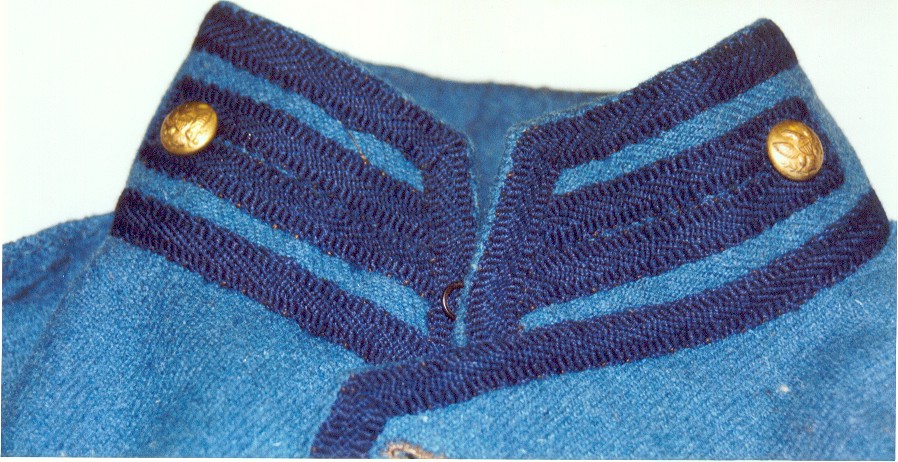
The jacket is trimmer throughout with 1/2" worsted wool blue lace.
It is trimmed around perimeter of collar, around jacket perimeter
from base of collar on buttonhole side around to bottom button on
button side. On cuff in a chevron pattern. The collar exhibits a 4"
double row of lace on the collar to simulate a false buttonhole.
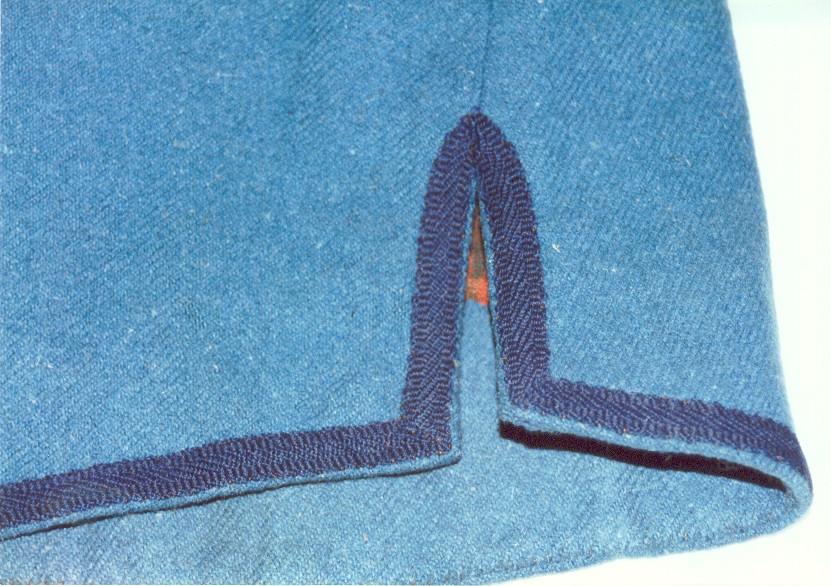 The
jacket has a four-piece collar. The height of the collar is 2 1/8"
in the front and 2 1/4" in the center. There is a single black metal
hook-n-eye set 1/2" up from the base of the collar. The side vent is
3 1/8" deep and 1/2" wide at the bottom. The
jacket has a four-piece collar. The height of the collar is 2 1/8"
in the front and 2 1/4" in the center. There is a single black metal
hook-n-eye set 1/2" up from the base of the collar. The side vent is
3 1/8" deep and 1/2" wide at the bottom.
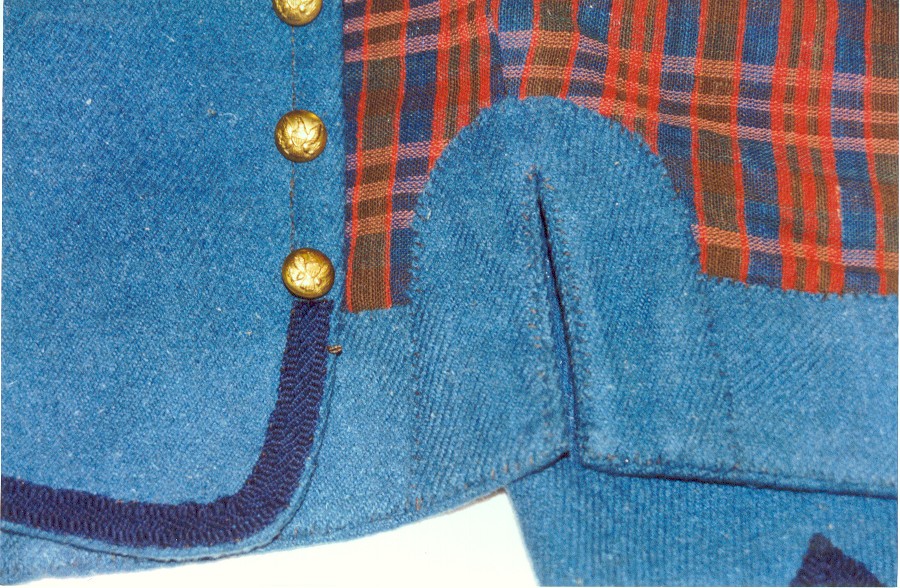
The width of the vent facing is 1 1/2" wide.
The
sleeve lining consists of two different fabrics. Both are green
polished cotton with a white pattern printed on them. The first is
in a "baske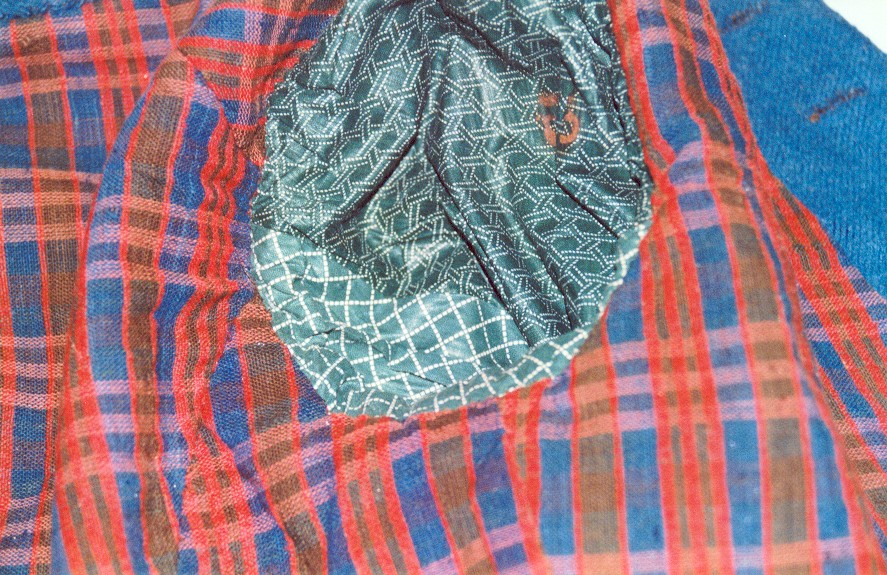 t
weave" pattern the second is a "grid" pattern. The sleeves linings
however are not matched. The upper sleeve lining of the left sleeve
matches the under sleeve lining of the right sleeve and visa versa. t
weave" pattern the second is a "grid" pattern. The sleeves linings
however are not matched. The upper sleeve lining of the left sleeve
matches the under sleeve lining of the right sleeve and visa versa.
(Note:
Another jacket formerly owned by Dean Nelson had sleeve linings made
from fabric identical to the basket weave pattern in this garment.
On this example from the Schuylkill Arsenal, both the upper and
under sleeve lining are made form the same fabric.)
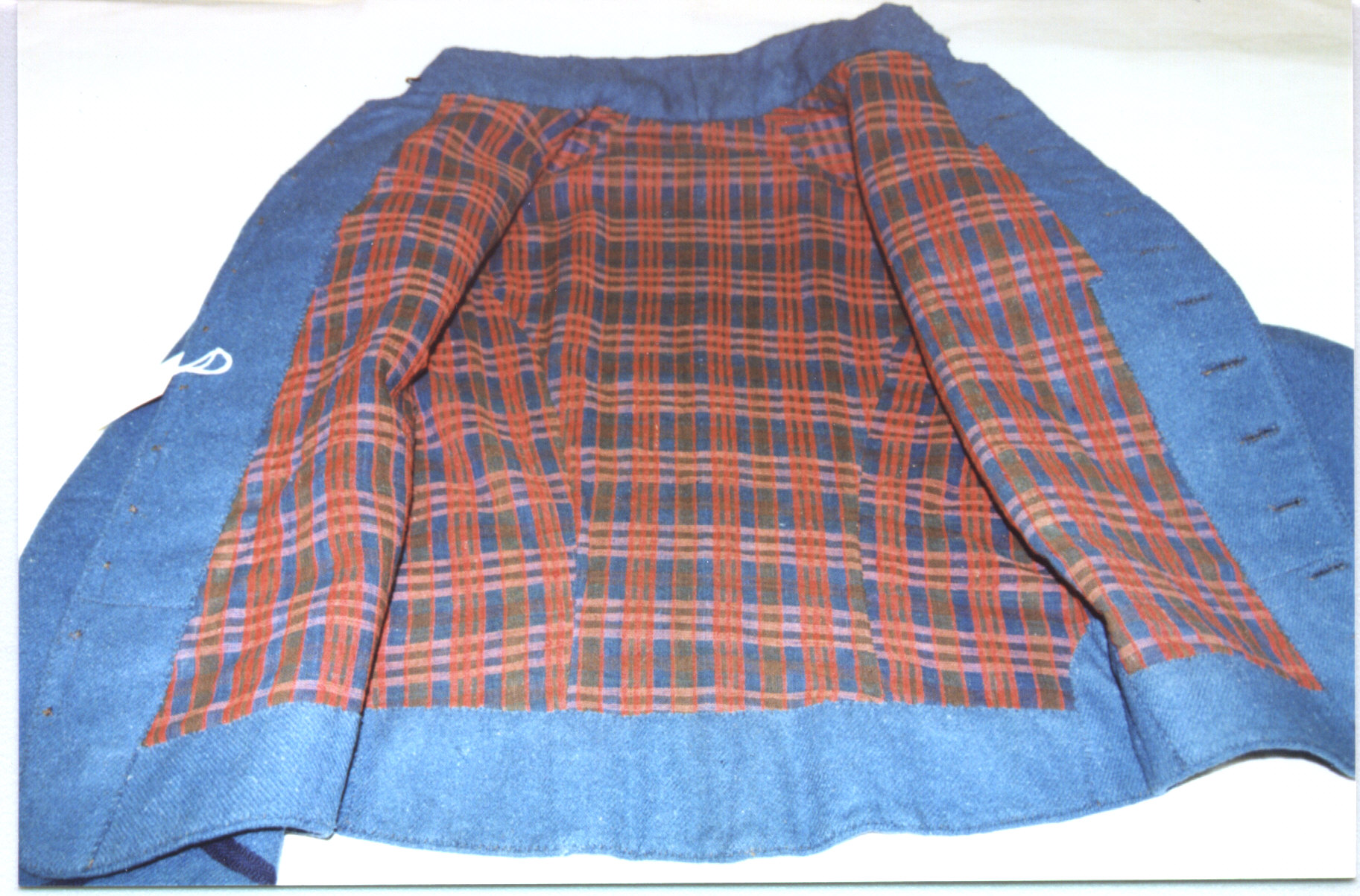
The left
sleeve is marked "S.A. 2" in dark red ink.
The body
lining is a plaid domet flannel material. The lining of the body is
5 pieces, there is no center back seam as seen in the body.
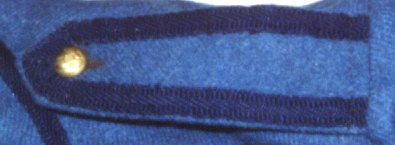
The functional shoulder straps are 5 1/2" long in the front, 6 1/4"
in the middle and 5 1/4" in the rear. They are trimmed with 1/2"
lace and have a 3/4" buttonhole. The facing piece is also raw edged.
It is topstitched 6-7 stitches per inch 1/4" along the shoulder
seam.
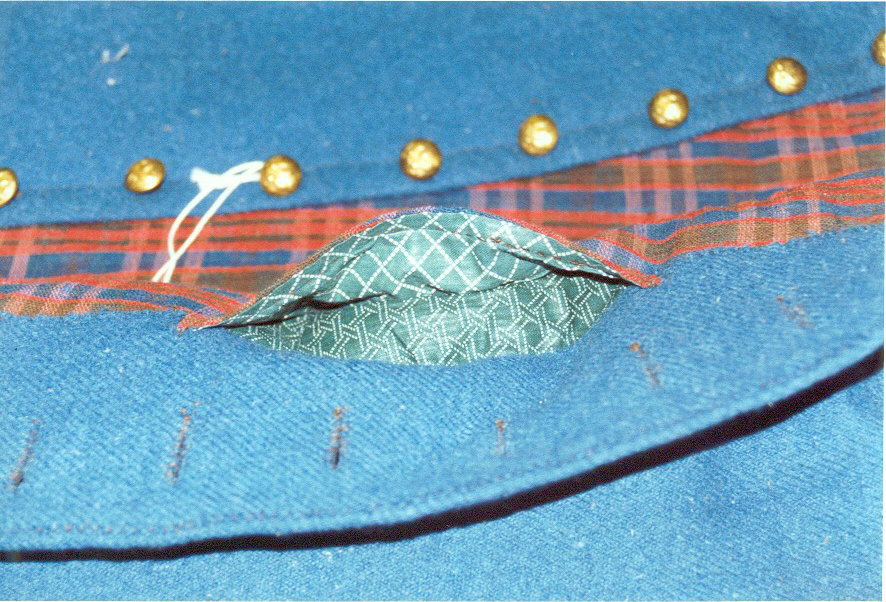
The pocket bag material is also cut similar to the sleeves. The
upper fabric is different than the under fabric. The opening of the
pocket is 5 1/4" wide. All facing pieces are overcast raw edged to
the body. The only top-stitching on the body is on the button side
of the jacket. This stitching is 1/2" from the edge and is 6-7
stitches per inch.
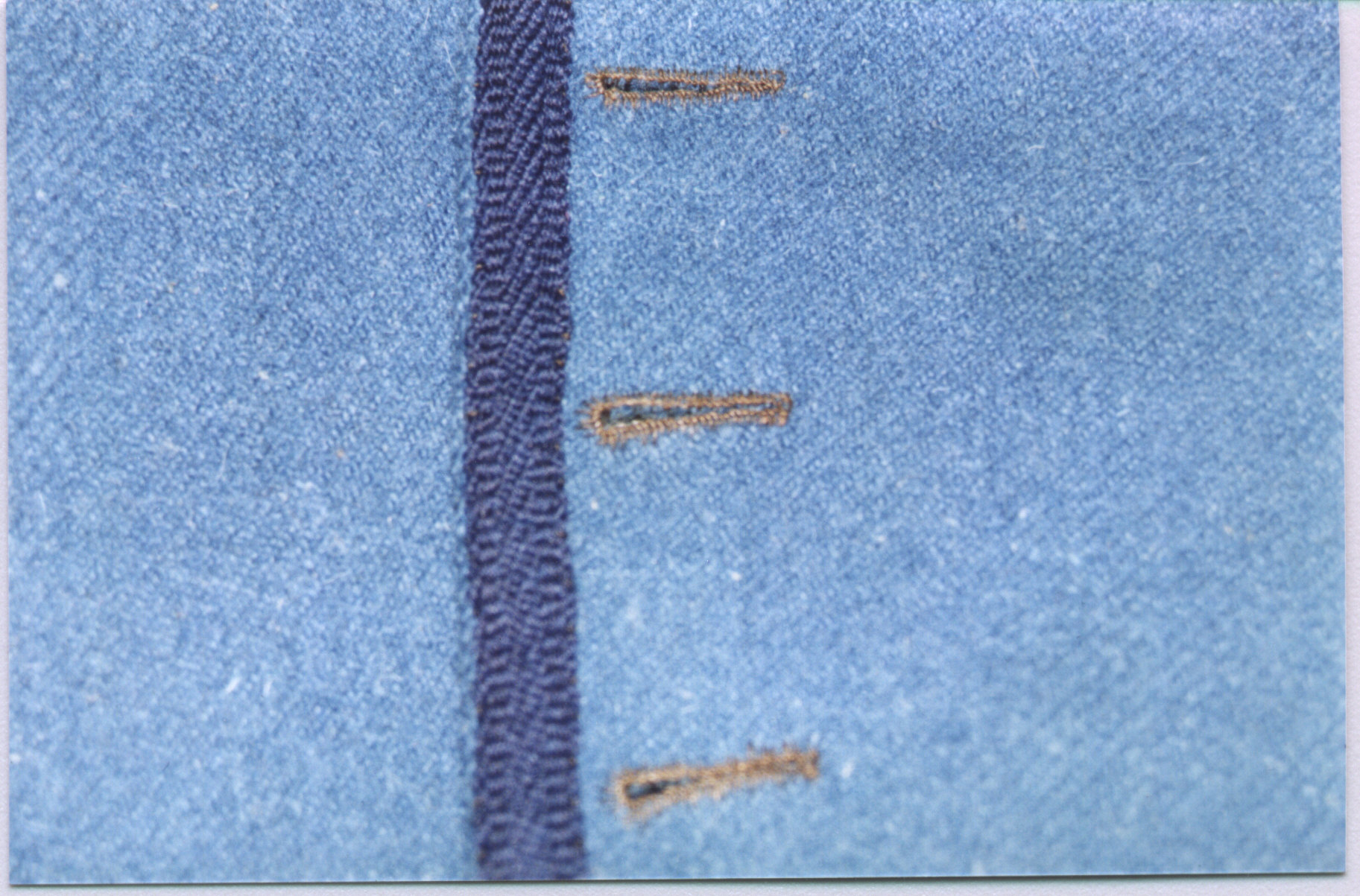
The
jacket has a 12 button front. The top buttonhole is placed 1" down
and 3/4" over and the bottom button hole is placed 3 1/8" up and
3/4" over. The buttonhole spacing is between 1 1/2" and 1 3/4"
apart. All buttons on the jacket have a Scovill backmark.
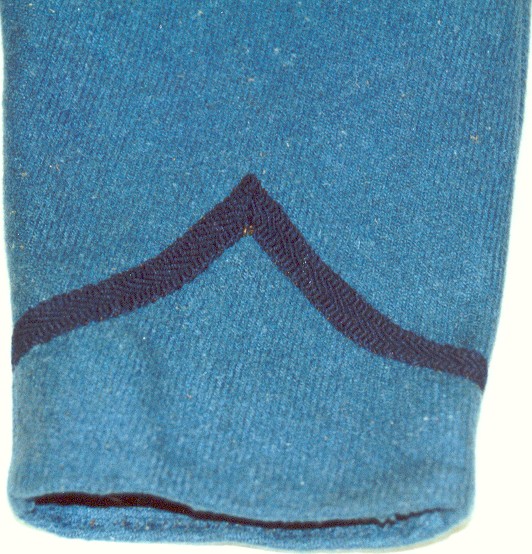
The cuff lace measurements are as follows: Front of sleeve is 1 1/3"
up from the bottom, the middle of the lace rises to 4 1/2" and the
lace falls to 1 5/8" at the rear of the cuff. The sleeve has a
separate facing piece that is 1" deep and is raw edged.
The length of the sleeve is 25", the width at the cuff is 5 7/8" and
the width at the elbow is 8" |
Special Thanks: The author would like to thank Ross
Kimmel for the loan of his Invalid Corps Jacket photos and notes;
Fred Gaede for his research on contractors and the quartermaster
department; Phil Katcher and Guy Smith for the permission to use
images in their collection and to Gettysburg National Military
Park which houses the original sample displayed on this page.
Further Reading:
Please check out Philip Katcher's Military Image's
article
The U.S. Army Veteran Reserve
Corps, 1863-1866
Click here to view photos of
Invalid Corps Bands and Officers
Here is a link that has all the
Veteran Reserve Corps Regimental
Histories
If you like to sing, please try the lyrics to
The Invalid Corps
written by Frank Wilder in 1863
Foot notes
1. Stinson, Byron, The Invalid Corps, CWTI, May
1071, pp22
2. Donald, David H. Gone for a Soldier: The Civil War memoirs
of Private Alfred Bellard, Little Brown and Company, Boston,
1975 p238
3. U.S. War Department, The war of the Rebellion: A Compilation
of the Official records of the Union and Confederate Armies,
Washington 1880-1901, Series III, Vol. 3 p549
4. Donald, David H. Gone for a Soldier: The Civil War memoirs
of Private Alfred Bellard, Little Brown and Company, Boston,
1975 p262
5. The 97th Company, 1st Battalion of Invalids was later
redesignated as Company C, 1 Regiment Veterans Reserve Corps.
6. Donald, David H. Gone for a Soldier: The Civil War memoirs
of Private Alfred Bellard, Little Brown and Company, Boston,
1975 p2
7. National Archives, Record Group 92, Entry 393, Cincinnati
Depot, Letters Sent, 12 January 1864 to 30 Sept 1865
Quartermaster sizes for the
Invalid Corps Jackets (measurements are in inches)
|
Measurement |
Size
#1 |
Size
#2 |
Size
#3 |
Size
#4 |
| Length of
back |
24 |
24 1/2 |
25 |
25 1/2 |
| Length of
coat |
32 |
33 |
34 |
35 |
| Length of
sleeve |
9 3/4 |
10 |
10 1/4 |
10 1/2 |
| Width of
bottom of back |
3 1/2 |
4 |
4 1/4 |
4 3/4 |
| Width of
side body |
6 |
6 1/4 |
6 3/4 |
7 1/2 |
| Width of
fore body |
9 1/2 |
10 |
11 |
12 1/2 |
| Width of
sleeve, hand |
6 |
6 |
6 |
6 |
| Width of
elbow |
8 1/4 |
8 1/2 |
8 3/4 |
9 |
| Width of
collar |
3 |
3 |
3 |
3 |
| Width of
breast |
36 |
38 |
40 |
42 |
| Width of
waist |
32 |
34 |
36 |
38 |
GENERAL ORDERS, WAR DEPT., ADJT. GENERALíS OFFICE,
No. 130. Washington, May 15, 1863.
In executing the provisions of General Orders, No. 105, from this Department, in regard to the selection of
men for the Invalid Corps, medical inspectors, surgeons in charge of hospitals, camps, regiments, or of boards
of enrollment, military commanders, and all others required to make the physical examination of men for the
Invalid Corps, will be governed in their decisions by the following list of qualifications and disqualifications for
admission into this corps:
Physical infirmities that do not disqualify enlisted men for service in the Invalid Corps.
1. Paralysis, if confined to the left upper extremity, and the manís previous occupation fit him for the duty of
clerk, orderly, &c.
2. Simple hypertrophy of the heart unaccompanied by valvular lesion; functional derangement of the stomach
(dyspepsia); mild chronic diarrhea; simple enlargement of the liver or spleen; a temporary ailment of the kidneys
or bladder.
3. Chronic rheumatism, unless manifested by positive change of structure, wasting of the affected limb or
puffiness or distortion of the joints.
4. Pain, unless accompanied with manifest derangement of the general health, wasting of a limb, or
other positive sign of disease.
5. Myopia, unless very decided or depending upon structural change of the eye.
6. Stammering, unless excessive and confirmed.
7. Loss of teeth or unsound teeth.
11. Stricture of the urethra.
12. Incontinence of urine.
13. Loss or complete atrophy of both testicles from any cause; permanent retention of one or both testicles
within the inguinal canal.
14. Varicocele and cirsocele.
15. Loss of left arm, left forearm or left hand, if the man be qualified for duty of clerk or orderly.
16. Loss of leg or foot, provided the man have the inclination and aptitude for service in a general hospital, and
1s recommended for that duty by a
medical officer, or if qualified for the duty of clerk or orderly.
17. Old and irreducible dislocation of shoulder and elbow in which the bones have accommodated themselves
to their new relations.
18. Muscular and cutaneous contraction of left arm, provided the man may be employed as clerk, orderly, or
messenger.
19. Loss of left thumb; partial loss of either thumb.
20. Loss of first and second phalanges of all the fingers of the left hand.
21. Total loss of any two fingers of the same hand.
22. Total loss of index finger of right hand.
23. Permanent extension of any finger of the right hand; permanent extension or contraction of any finger
of the left hand.
24. Adherent or united fingers.
25. Loss of any toe or toes except the great toe; all the toes joined together.
26. Deformities of the toes, if not sufficient to prevent walking.
27. Large, flat, ill-shaped feet that do not come within the designation of talipes valgus.
28. Varicose veins not accompanied with ulcerations.
29. Gunshot wounds or injuries not involving loss of function.
30. None of the foregoing infirmities disqualify officers for service in the Invalid Corps.
In all cases
where the physical infirmities of officers or enlisted men
come within the provisions of the above list they will be
recommended for transfer to, or enlistment in, the Invalid
Corps; but no one will be admitted into this corps whose
previous record does not show that he is meritorious and
deserving, and that he has complied with the provisions of
General Orders, No. 105, War Department, Adjutant-Generalís
Office, 1863, authorizing
an Invalid Corps.
Physical infirmities that disqualify enlisted men for service in the Invalid Corps.
1. Manifest imbecility or insanity.
2. Epilepsy, if the seizures occur more frequently than once a month, and have obviously
impaired the mental faculties.
4. Acute or organic diseases of the brain or spinal cord, of the heart or lungs, of the stomach
or intestines, of the liver or spleen, of the kidneys or bladder, sufficient to have impaired
the general health or so well marked as to leave no reasonable doubt of the manís incapacity for
military service.
5. Confirmed consumption, cancer, aneurism of important arteries.
6. Inveterate and extensive disease of the skin.
7. Scrofula or constitutional syphilis which has resisted treatment and
seriously impaired the general health.
8. Habitual or confirmed intemperance or solitary vice sufficient in degree to have materially
enfeebled the constitution.
9. Great injuries or diseases of the skull, occasioning impairment of the intellectual faculties,
epilepsy, or other serious nervous or spasmodic symptoms.
10. Total loss of sight or other serious diseases of the eye, affecting its integrity and use.
11. Loss of nose or deformity of nose, if sufficient seriously to obstruct respiration; ozena,
if dependent upon caries.
13. Dumbness; permanent loss of voice.
14. Total loss of tongue; partial loss and hypertrophy or atrophy of tongue, if sufficient to
make the speech unintelligible and prevent mastication or deglutition.
15. Incurable deforniities of either jaw, whether congenital or produced by accident, which would
prevent mastication or greatly injure the speech.
16. Tumors of the neck impeding respiration or deglutition; fistula of larynx or trachea.
17. Deformity of the chest sufficient to impede respiration or to prevent the carrying of arms and
military equipments; caries of the ribs; gunshot wound of the lung, if complicated with fracture of a rib.
18. Artificial anus; severe stricture of the rectum.
19. Total loss or nearly total loss of penis; epispadia or hypospadia at the middle or nearer the root of
penis; stone in the bladder.
20. Confirmed or malignant sarcocele; hydrocele, if complicated with organic disease of the testes.
21. Excessive anterior or posterior curvature of spine; caries of the spine; lumbar abscess.
23. Wounds, fractures, tumors, atrophy of a limb, or chronic diseases of the joints or bone that would
prevent marchino siderable muscular exertion
24. Anchylosis or irreducible dislocation of the shoulder, elbow, wrist, hip, knee, or ankle joint.
25. Muscular or cutaneous contractions from wounds or burns in degree sufficient to prevent useful
motion of the right arm or of the lower extremities.
26. With the exception of those paragraphs which refer to the total or partial loss of an extremity, the
foregoing disabilities disqualify officers as well as enlisted men for service in the Invalid Corps.
In all cases where the physical infirmities of an officer or enlisted man come within the provisions of
this list, or where his previous record shows that he is not entitled to be received into the Invalid Corps,
lie will, if in service, be discharged, and if an applicant to re-enter, his application will be disapproved.
Whilst the Government is most anxious to provide for and employ to the best of their abilities those
faithful soldiers who, from wounds or the hardships of war, are no longer able to perform active duty in the
field, yet it can upon no account permit men undeserving or totally disabled to re-enter its service.
Those faithful soldiers whose physical infirmities are too great to admit of their being of any use in the
Invalid Corps will, nevertheless, receive the pensions and bounties provided by law.
It is further announced that no officer or enlisted man shall be entitled to or receive any pension, premium,
or bounty for enlistment, re-enlistment, or service in the Invalid Corps. They will receive all other pay and
allowances now authorized by law for the U. S. infantry, except the increased pay for re-enlistment. Claims for
pensions or bounties which may be due for previous service will not be invalidated by enlistment in the Invalid
Corps. But no pensions can be drawn or accrue to the benefit of any man during his service in said corps. The
officers and men will be organized into companies of infantry of the same strength as is now authorized by law
for the U. S. infantry. No organized brigades, regiments, companies, or parts of companies will be accepted as
such. Enlistments in this corps will be for three years, unless sooner discharged.
By order of the Secretary of War:
Assistant Adjutant- General.
|
|
|



